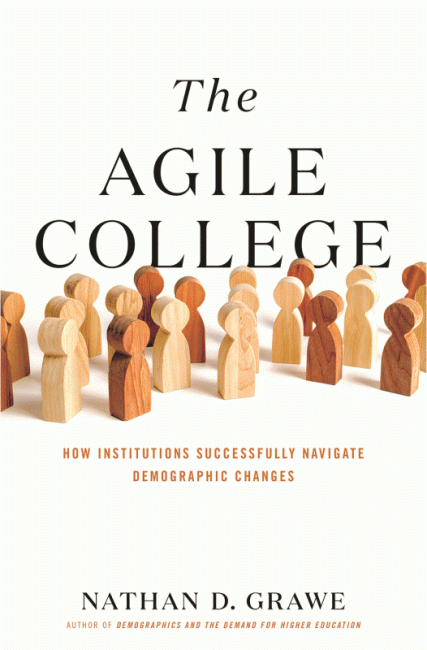You have /5 articles left.
Sign up for a free account or log in.

Johns Hopkins University Press
It’s been three years since Nathan D. Grawe’s book Demographics and the Demand for Higher Education was published, drawing widespread attention for detailed projections about who traditional-aged college students are likely to be in the coming decade-plus and where they will be most likely to want to enroll.
This month Grawe is back with a sequel, The Agile College (Johns Hopkins University Press). The new book starts out like the previous one, with an updated set of even-more-detailed projections peering farther into the future than was previously possible, into the mid-2030s.
Although it might be disappointing to those worried about shrinking student cohorts threatening higher education’s business model, many of the main takeaways don’t change. Recent years of falling birth rates are driving down the number of teenagers expected to graduate from high school and enroll in college. A short recovery in the number of college-bound students expected in 2031 and 2032 doesn’t change an overall downward trend between the middle of the 2020s and the middle of the 2030s.
Generally, student populations can be expected to shift away from the Northeast and Midwest, even as they diversify -- growing less white, less non-Hispanic Black and more Hispanic. Demand for college can be expected to vary greatly by institution type and geography. Over all, though, selective institutions are likely to remain in greater demand than the less selective, many of which face significant declines by the end of the projections.
But the new book adds a lengthy discussion of strategies colleges and universities might use to try to adapt to this future. Fueled by interviews with different higher education leaders, its second half examines different recruitment initiatives, retention programs, academic program changes, institutional growth plans, retrenchment efforts and collaborative actions that some colleges and universities are already trying.
The result is a book that might seem written to kick-start strategic planning processes or just provide an overview of the dozen years on the horizon -- a detailed environmental scan followed by discussion of what institutions might do to make their futures less perilous and more exciting.
“The examples described in later chapters demonstrate that as disruptive as recent demographic shifts can be, schools that constructively engage the changing environment can emerge stronger as a result,” Grawe writes. “Armed with projections of the future and proactive examples, higher education can prepare to meet the needs of the next generation of students.”
Grawe, a professor of social sciences and economics and a former associate dean at Carleton College, answered questions about his new book via email. The following exchange has been edited for style and length.
 Q: How did feedback from the those who read Demographics and the Demand for Higher Education influence how you approached this book?
Q: How did feedback from the those who read Demographics and the Demand for Higher Education influence how you approached this book?
A: In some sense, the entire project is a response to what I have learned through talking with others about my prior work. For instance, in the opening section, which reviews demographic trends and updates model projections, I’ve added several disaggregations -- particularly separating public vs. private institutions and dividing students by their propensity to transfer or persist. These additions followed from conversations with leaders who were trying to dig deeper into the meaning of the baseline projections. More importantly, the second section of the book, which explores how proactive campuses are adapting to the changing environment, is an homage to the constructive efforts by so many to find new pathways that diverge from projections based on past college-going outcomes.
Q: Did you think of any ways to slice the data that you were unable to include or wish you could have included?
A: A social scientist would always like more data! A comprehensive wish list would be too long, but here are a few items from the top of that list.
It would be great if the Census data had even more observations. While a resource like the American Community Survey is very large, when you start to cut the data in multiple dimensions you inevitably run into smaller samples, which inherently mean greater sampling error in the projections. With an idyllic data set, we’d be able to parse geography into very local markets. As it is, I used data on the level of state and large cities so that users can create their own regions, but I kept the analysis to the regional level.
With more observations, one could imagine further dividing institutions. How might the future for single-sex institutions look as compared to coeducational colleges and universities? What about religiously affiliated institutions? Similarly, larger sample sizes would permit greater granularity in the dimension of race now that the Census Bureau permits much greater specificity in self-identification.
In addition to a larger data set, I’d love to have been able to explore the types of programs students chose. Absent some change, what might we expect for the future of STEM enrollments or enrollments in the arts?
Q: Speaking of change, you were writing this at the end of 2019, and you noted that projections are based on institutions and people acting as they have historically. Do you think the pandemic will change behavior long term?
A: That’s a pressing question of the moment. The National Student Clearinghouse Research Center finds that pandemic-induced enrollment losses were particularly pronounced among underrepresented minorities and low-income students. If expanded access will be part of the way that higher education responds to demographic change, then we really must hope that present enrollment patterns are an unsettling blip rather than the start of a new trend.
More broadly, all students are experiencing a fundamental change in how they engage with learning. By upending common practice, the pandemic has invited an entire cohort of students to rethink what forms of education work best for them. For some, distance learning may remind them of the power of intimate interactions with teachers and peers, motivating them to seek out vibrant residential communities. At the same time, others will have their eyes opened to new possibilities through online learning. As students reimagine education, institutions have an opportunity to have new conversations with students who might not have been in their market in the past.
With changing attitudes among students and evolving institutional practices, it will take some time to learn just how the pandemic will alter long-term attendance patterns.
Q: Are you monitoring any other factors that might change the long-term projections?
A: Looking at the very long run, fertility in the pandemic is interesting to consider. Drawing on patterns of fertility from the 1918 pandemic, Phillip Levine and Melissa Kearney estimate that we may see 300,000 to 500,000 fewer babies born in 2020 than in 2019. That would be a decline of almost 10 percent in just one year. While we might hope that some of this decline represents delayed rather than forgone births, it still adds greater strain to a demographic picture that has been in decline for more than a decade now.
In the more immediate time frame, I think we are all anxious to achieve equity in college attendance across racial and ethnic groups. Clearly, justice calls for us to close these gaps. It would be lovely to have the projections proven pessimistic as a result of reaching those goals.
Q: The Western Interstate Commission for Higher Education released projections in December showing, in part, a larger-than-expected number of private high school graduates through the middle of the 2020s. How much could this or other developments that boost enrollment rates blunt the long-term trends you’re projecting for colleges?
A: I read that part of the WICHE report as largely consistent with my projection of rising numbers of young people with demographic markers associated with attendance at elite colleges and universities. Rising numbers of parents with bachelor’s degrees coupled with high returns to education generate both interest and capacity to demand these forms of education. But we must remember that while such institutions are an important subpart of the bigger picture, the vast majority of young people attend public high schools and go on to colleges and universities ranked outside the top 100. So I don’t expect these trends to blunt the bigger picture. In fact, the divergent trends we see across school types in K-12 (in the WICHE report) and across higher education (in my work) create challenges as the education system attempts to address cross-cutting issues even as institutions within the industry experience very different pressures.
Q: You spend half of this book discussing tactics and strategies different institutions can use to adapt to the future. Why?
A: As I’ve talked with people on campuses across the country, I have been struck by the amazingly positive and productive responses that are being taken. Resiliency and a determination to adapt to a changing environment shine through. Whether redefining “students we serve,” revising academic programs, raising retention or strategically downsizing, there are so many paths that lead institutions to more sustainable futures with greater service to their students.
Of course, every institution lives within its own context. What works at one institution may not work at another. My hope is that providing a wide range of examples drawn from institutions of many types might spark conversations on campuses that are grappling with changing demographics and want to chart a path of their own toward a successful future.
Q: Are there any tactics you want to highlight or that you feel have been underdiscussed in higher education circles?
A: Retention initiatives will be incredibly important in coming years. If higher education were to reduce attrition by even 25 percent, we would offset much of the potential losses associated with declining student pools. Such work also plays a central role in efforts to promote access. While matriculation rates for the fall following high school graduation are an important benchmark, we obviously aspire to more than simply bringing students to campus -- we want to nurture them through graduation and launch them into meaningful lives beyond college. So, as we pursue equity in access, attention to student success will become even more important.
Q: At one point you wrote about accountability being a necessary part of change. But colleges and universities sometimes struggle with accountability because so many constituencies have a finger in the pie. Where does accountability come from at a college or university facing an uncertain enrollment future?
A: When change is proposed, it is not uncommon to hear appeals to historical precedent like “We’ve never done it that way before.” Reminders of our past are often helpful antidotes to faddishness. But when the environment around us is changing, the fact that something hasn’t been tried before may be a virtue. According to the Department of Education, in the six decades beginning in 1954, higher education experienced persistent enrollment growth: throughout this period, in each year enrollments were greater than they had been five years before. And that growth was often robust. From 2001 to 2012, each five-year period witnessed growth of 10 percent or more. However, from 2010 through 2018, enrollments declined in each year. Losses have been most pronounced in the Great Lakes and Middle Atlantic regions, which have experienced demographic weakness.
Even as the future calls for agility and openness to new ways of working, experimentation must be disciplined by accountability to results. Various stakeholders may bring their own perspectives and experiences, but ultimately our investments in initiatives to expand access, reach new markets and promote student success should be evaluated against empirical evidence of effectiveness.




